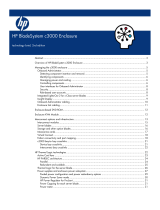
Technology Update Volume 8, Number 1
4
Additional resources
For additional information on the topics discussed in this article, visit:
“Integrating HP ProLiant Lights-Out
processors with Microsoft® Active Directory”
Integration Note
http://h20000.www2.hp.com/bc/docs/support/Support
Manual/c00190541/c00190541.pdf
Microsoft TechNet online publication,
“Understanding Domains and Forests”, from
Windows Server 2003 Product Help
http://technet.microsoft.com/en-us/library/cc780307.aspx
Meet the Expert— David Koenen
David Koenen is a Master Engineer in HP Industry Standard Servers (ISS). His
responsibilities include specifying I/O Virtualization features for NICs, Converge
Network Adapters for FCoE, network performance consulting, and editor of the
Energy Efficient Ethernet for Backplane PHYs on the IEEE 802.3az Task Force.
Wayne Opland, David’s manager, says “David is our networking scout. He is an
engineer who understands current technology, what’s coming, and how our
customers use networking. He has been recognized by his peers in the industry by
making him the editor for the Energy Efficient Ethernet standard.” Wayne marvels
at David’s “ability to grasp complexity.”
David has been married for 16 years to Lynda, and they have three children:
Tamara (11), Geoffrey (9), and Andrew (7). He enjoys jogging, coaching youth
sports, camping, boating, water skiing, snow skiing, snow-boarding,
woodworking, and scrapbooks.
Below are excerpts from an interview with David (and Wayne).
Why did you decide to become an engineer?
David: I was greatly inspired by my father who was a machinist, draftsman, an
airline electrician (avionics), and an amateur carpenter. I watched and learned as
he fixed things around the house, but most of all, he taught me about the
development process—design on paper, make a list of materials, and build to the
plan. He also showed me around the cockpits of commercial airliners and told me
that the engineers who designed and built them “make the big bucks.” I was also
inspired by a tour of Kennedy Space Center in Florida during one of our
vacations, so in my senior year in high school (1978) I took a really cool course in
Digital Electronics. When I went to college, I chose the Aerospace Engineering
program, but the odds of becoming an astronaut (50,000 applicants to 12
positions) were not in my favor. So, I took mostly electrical engineering electives.
After graduating, I worked on military avionics for a while before coming to
Compaq in 1991. Later, with Compaq’s tuition reimbursement, I decided to go
back and get an advanced degree in Electrical Engineering.
Name: David Koenen
Title: Master Engineer, ISS Server NIC
Technologist
Years at HP: 17
University/Degree:
University of Minnesota,
Minneapolis, MN: Bachelor of
Aerospace Engineering and
Mechanics, 1984
University of Houston, Houston, TX:
Masters of Electrical Engineering,
1998
U.S. Patents: 9






